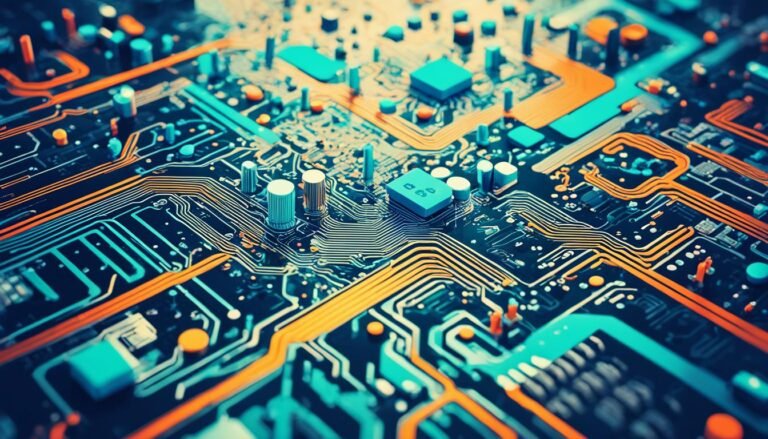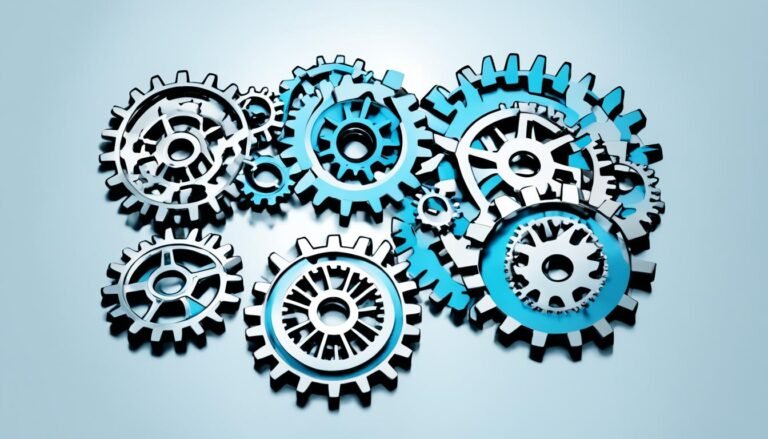5G Devices: Comparisons of 5G-enabled devices and their performance.
Did you know 5G technology can reach data rates of up to 10Gbps? That’s 10 to 100 times faster than 4G. This new network changes the game with super-fast speeds and super-low latency of just 1 millisecond. It opens doors to real-time interactions and new tech like self-driving cars and remote surgeries.
5G doesn’t just stop at speed. It can handle more devices than 4G, making connections for the Internet of Things (IoT) smoother. This means your smart devices, from phones to wearables to smart home gadgets, work together seamlessly.
5G is also kinder to the planet. Its smart network design and tech use less power. This means it’s better for the environment.
But, not every country has 5G yet. Leaders like South Korea and Puerto Rico are ahead, offering it to many users. As 5G spreads worldwide, more people will get to see its amazing benefits.
Key Takeaways:
- 5G technology provides data rates up to 10Gbps, making it 10 to 100 times faster than 4G.
- 5G networks offer ultra-low latency of 1 millisecond, enabling real-time interactivity and applications like autonomous driving.
- 5G supports a higher number of connected devices, enhancing connectivity for IoT devices.
- 5G networks are more energy-efficient, reducing environmental impact.
- South Korea and Puerto Rico lead in 5G availability and user coverage.
What is 5G and its key specifications
5G technology is the latest in telecom networks, a big step up from before. It’s all about making our digital lives better with fast speeds, quick responses, and better connections. Let’s look into what 5G offers and its main features.
5G is all about giving us faster data rates. This means smoother streaming, quicker downloads, and real-time chats. With speeds up to 10Gbps, it’s way faster than 4G, making getting information and enjoying media a breeze.
5G isn’t just fast; it’s also super quick to respond. With a delay of just 1 millisecond, it’s perfect for fast-paced activities like online gaming, video calls, and IoT use. This means less waiting and more doing.
5G can handle a lot more devices in a small area than 4G. It has 1000 times more bandwidth per area, which means more devices can connect without slowing down. This is great for smart homes, cities, and all the connected devices we use every day.
5G also aims for almost perfect uptime, aiming for a 99.999% availability rate. This means fewer outages and a reliable network for everyone, all the time.
5G is also all about being efficient. It uses 90% less energy than 4G, making it better for the planet. Plus, IoT devices can last up to 10 years on a single battery, cutting down on waste and upkeep.
To wrap it up, here are the main points about 5G technology:
- Data rate of up to 10Gbps
- 1 millisecond latency
- 1000x bandwidth per unit area compared to 4G
- Support for up to 100x more connected devices per unit area
- 99.999% network availability
- 90% reduction in energy usage
- Up to 10-year battery life for low-power IoT devices
How fast is 5G and its speed variations
5G speed is truly amazing. It brings new levels of connectivity with its advanced tech. This means super-fast data transfer and unmatched user experiences.
5G can go up to 10 gigabits per second (Gbps). That’s 10 to 100 times quicker than 4G. You could download an HD movie in seconds or stream high-definition content without waiting.
But, the actual speed of 5G can change for many reasons. Being close to a 5G tower and environmental factors affect the speed and stability. Speed tests show average 5G speeds from 220Mbps to over 950Mbps in different cities.
Being near a 5G tower with a clear view can make speeds over 1000Mbps. This means great performance for things like gaming, virtual reality, and streaming videos.
Download and upload speeds can change based on your location and how close you are to the tower. Some areas get super-fast 5G speeds. Others might have slower speeds due to network issues.
5G vs 4G: The differences and advantages of 5G
When you hear about network connectivity, you might think of 5G and 4G. These two offer mobile internet, but 5G has some big differences. Let’s explore what makes 5G better.
Capacity and Speed
5G can support way more devices than 4G. It can handle at least 100 times more devices. This is great for the growing Internet of Things (IoT). Plus, 5G is faster, so downloading and streaming is smooth without lag.
Low Latency
5G is also known for its super low latency. Latency is how long it takes for data to move between devices and networks. While 4G takes about 50 milliseconds, 5G can do it in just 1 millisecond. This is key for things like self-driving cars, augmented reality, and remote surgery.
Enhanced Service Deployment and Energy Efficiency
5G networks make it easier to add new services and apps quickly. This means businesses and users can try out new tech faster. Plus, 5G uses less energy than 4G. This means it’s better for the planet and devices last longer.
5G has many benefits over 4G, like more capacity, speed, low latency, and better service deployment. As we connect more, 5G is making new technologies and apps possible that we couldn’t imagine before.
The 8 currencies of 5G networks
5G networks bring many benefits and new features. They have eight key currencies that set them apart from older networks. Let’s look at these currencies and see why they’re key for 5G’s success.
1. Throughput:
Throughput is how much data a network can send in a set time. 5G lets users send and receive data much faster. This means smoother web browsing, streaming, and file sharing.
2. Service Deployment:
5G makes it quicker to roll out new services and apps. This speed helps businesses innovate faster. It also makes the user experience better.
3. Mobility for High-Speed Travel:
5G keeps devices connected even when moving at high speeds, like on trains or in cars. This is key for things like self-driving cars and uninterrupted communication.
4. Support for a Higher Number of Connected Devices:
5G can handle more devices at once. This is great for the growing Internet of Things (IoT). It means more devices can talk to each other without problems.
5. Energy Efficiency:
As more devices connect, saving energy is important. 5G uses less power but gives faster speeds and better performance. This is good for the environment and our wallets.
6. High Data Volume Capacity:
5G can move and store a lot of data. This is perfect for things like augmented reality (AR), virtual reality (VR), and streaming high-quality videos.
7. Low Latency:
Low latency is key for real-time apps and services. 5G’s low latency means quicker responses. This is great for online gaming, remote surgery, and self-driving tech.
8. Reliability:
Reliability is vital for important tasks. 5G networks are more reliable, keeping connections strong even in busy places or emergencies.
The 8 currencies of 5G networks start a new era of connectivity. They offer faster speeds, better reliability, and support for new tech. This will drive innovation across many industries. As 5G grows, we’ll see more exciting changes that will change our digital world.
5G Availability and Future Projections
Since its launch, 5G technology has grown a lot, changing how we connect and talk. Now, over 1.1 billion people worldwide use 5G, showing the need for faster and more reliable internet.
Many countries are building strong 5G networks, making us more connected. By 2025, 2 billion people will use 5G, showing how fast it’s spreading.
5G is not just a technology; it is a catalyst for digital transformation.
The future looks bright for 5G. By 2028, it’s expected to have 4.6 billion subscriptions, driving new ideas and helping many industries.
Not all places have the same 5G coverage yet. South Korea and Puerto Rico lead with great coverage and speed. In Europe, Finland and Bulgaria are ahead, while others are catching up.
More investment in 5G will make it available to more people worldwide. As countries work on 5G, we’ll see a big increase in its use and reach.
5G offers many new possibilities, from better mobile services to helping IoT devices and self-driving cars. It will change industries and daily life in big ways.
Unlocking a Connected Future
5G’s speed and power excite both businesses and users about a more connected world. As 5G spreads, the chances for new ideas are endless.
Putting more cell towers and improving network coverage is key to getting 5G to everyone. With tech advances and more devices supporting it, 5G will soon be for everyone.
It’s important for groups like regulators, telecoms, and tech companies to work together on 5G. This way, we can make the most of 5G, changing industries, improving connections, and sparking innovation.
The future is bright for 5G, and its wide use will change how we live, work, and connect in the coming years.
5G+ Technology and its Benefits
5G+ technology is an upgraded version of 5G. It offers many benefits for users and businesses. With millimeter wave technology, 5G+ provides fast network speeds and a lot of capacity. This changes how we connect and communicate.
One big plus of 5G+ is how it handles lots of users at once. It has faster speeds and can support more people. So, users can stream live events, play online games, or use apps without any lag.
5G+ technology opens up a world of possibilities and fuels innovation across industries. The increased network speed and capacity enable businesses to deploy cutting-edge technologies such as augmented reality (AR), virtual reality (VR), and the Internet of Things (IoT) at scale, transforming the way we live, work, and interact.
5G+ also means faster downloads. What used to take minutes, like downloading HD movies or big files, now takes seconds. This saves a lot of time and makes life easier for both people and businesses.
Also, 5G+ technology works better in more places than standard 5G. So, users can stay connected everywhere, whether in cities, rural areas, or on the move. This means no more losing signal in different locations, making everything smoother.
The advantages of 5G+ technology are huge. They lead to faster speeds, better experiences, more productivity, and new uses. 5G+ is changing the way we connect and opens up a new era.
Conclusion
5G devices bring a big step up in speed, latency, and connectivity over older tech. They can reach speeds of up to 10Gbps and have latency as low as 1 millisecond. This means super-fast and quick network performance.
5G can handle more devices at once, which is great for the Internet of Things (IoT). Billions of devices can now work together smoothly. This opens up new possibilities for communication and interaction.
5G isn’t just about faster internet. It’s changing many industries and making new applications possible. Things like self-driving cars and remote surgeries are now possible thanks to 5G’s low latency and high speed.
5G is getting more common as it spreads and gets more investment. As it keeps getting better, the future looks bright for 5G devices. They promise better connectivity, new solutions, and big changes in how we experience things.







